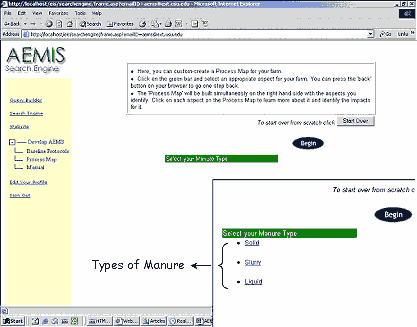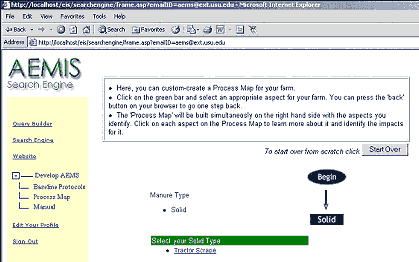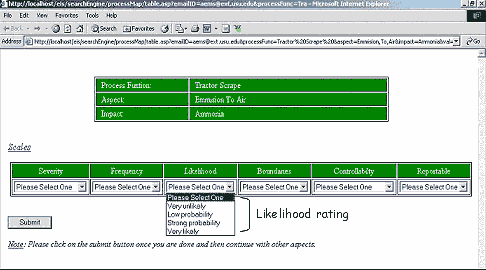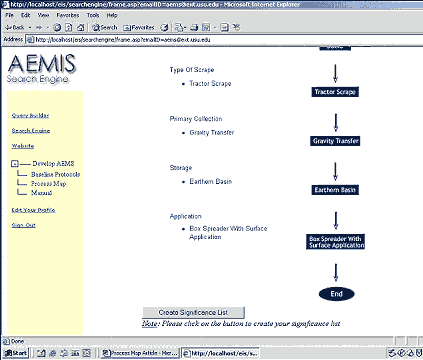April 2005 // Volume 43 // Number 2 // Tools of the Trade // 2TOT5
Agriculture Environmental Management System Electronic Manure Handling Process Map
Abstract
Utah State University Cooperative Extension
Agriculture Environmental Management Systems participants developed an electronic
process flow method for identifying aspects and assessing impacts from the
manure handling systems on animal feeding operations. This method breaks
the manure handling system into manageable portions by delineating every
process and support activity on a process flow diagram. Then each process
and activity is individually examined to identify associated aspects. This
approach expedites the identification of aspects in relation to those processes
and activities. It also fulfills the operational control condition to "identify
those operations and activities that are associated with identified significant
environmental aspects."
Introduction
Implementation of an Agriculture Environmental Management System (AEMS) is intended to result in improved environmental performance (Block, 1999; Harrison, 2002). Agriculturalists are generally unfamiliar with the terms "aspects" and "impacts" (Jackson, Kirschner, Serber, Koelsch, Risse, & Bird, personal communication, December 17, 2001).
Conceptually, these terms are in numerous agricultural best management practices (BMP). Additionally, these terms are alluded to in various EMS standards and industry codes of practice. However, the terms are well defined by American National Standards Institute/International Standards Organization (ANSI/ISO) 14001, Environmental Management Systems - Specifications with Guidance for Use (1996).
According to ANSI/ISO 14001, an environmental aspect is an "element of an organizations activities, products, or services that can interact with the environment" (1996). They continue by defining environmental impacts as "any change to the environment weather adverse or beneficial, wholly or partially resulting from organizations activities, products, or services" (ANSI/ISO, 1996).
Block (1999) identifies various methods for determining aspects and impacts. Most of these approaches are neither simple nor rational for agriculture producers and their advisors. But she defines and recommends the Process Flow Method as the easiest and most comprehensive way of identifying environmental aspects.
Electronic Process Flow Method
Following Block (1999), Utah State University Cooperative Extension Agriculture Environmental Management Systems (AEMS) participants have developed an electronic process flow method for identifying aspects and assessing impacts from the manure handling systems on animal feeding operations. This method breaks the manure handling system into manageable portions by delineating every process and support activity on a process flow diagram. Then each process and activity is individually examined to identify associated aspects. This approach expedites the identification of aspects in relation to those processes and activities. It has the added benefit of fulfilling the operational control condition to "identify those operations and activities that are associated with identified significant environmental aspects."
The manager of the animal feeding operation co-produces a process flow diagram of their manure handling system. Identification of the process flow method begins when a producer logs into the USU Agriculture Environmental Management Information System (AEMIS) on the USU AEMS Web site (http://aems.aste.usu.edu) as a guest or cooperator (Harrison, Kanade, & Toney, 2004). Once into the system, the user can find all the capabilities associated with this very powerful tool meeting the needs.
Figure 1 shows the user interface for AEMIS. The producer can then click on the link "Develop AEMS" on the menu that appears on the left hand side of the screen, which reveals a three-step process for developing an AEMS. However, this article focuses on the "Process Map" portion of the procedure. Details concerning "Developing an AEMS" are more thoroughly discussed in previous publications (Harrison & Toney, 2004; Harrison, Kanade, & Toney, 2004; Harrison, 2002).
Figure 1.
AEMIS User Interface

In the second step, a farm producer is able to tailor a Process Map suited to his farm that can be referred to any time once the user logs in. Producers begin co-production of their own process map by first identifying the type of manure (solid, slurry, or liquid) that they are handling.
When the user clicks on the green bar entitled "Select Your Manure Type," a selection of different types of manure is revealed (Figure 2). Once the user chooses a specific type of manure, the different varieties of manure under the selected category are displayed.
Figure 2.
Types of Manure

Figure 3 shows that, in this example, the producer has selected Solid manure and the Solid types are displayed. From this point on, the producer makes selections suitable to his operation until an entire process map is achieved. Throughout the entire selection procedure (or process mapping), a flow chart is simultaneously created on the side that gives a diagrammatic process map representation of his farm.
Figure 3.
Displaying Types of Solid

Environmental Aspects and Impacts Co-production
After the process flow diagram is completed, the producer is in the position to co-examine every step in every identified process or activity in order to delineate any associated environmental aspects. This approach served two purposes. First, it enables the producer to identify aspects in small, manageable portions, thereby decreasing the likelihood that significant aspects will be overlooked. Second, it enables the producer to link the identified aspects to specific operations and activities. This comprehensive process flow diagram delineates:
-
Where every process or activity begins, in terms of the receipt of manure,
-
The nature of any manure treatment that occur as part of the process or activity, and
-
Where every process or activity ends, in terms of intermediate or final land application.
Each "Aspect" of the process map has various "Impacts" associated with it. These impacts are typically viewed as emissions to air, releases to water and nutrient loading of the land (Figure 4). It is not necessary for an aspect to have an actual impact; the potential for a significant impact is sufficient to designate an aspect as significant. Thus, to successfully manage aspects to avoid a significant impact, the producers identify and evaluate the potential impacts to avoid an adverse environmental impact in the future.
Figure 4.
Aspects and Impacts for
Every Identified Activity/Process

Once the environmental impacts are identified, each impact is evaluated to establish the magnitude of impact. This evaluation becomes the basis for determining significance. Environmental impacts can be evaluated on a number of ways. The AEMS program has selected a combination of evaluation criteria that are appropriate for the producer's operations and activities. All evaluation criteria employ a four-point rating scale. Once a rating scheme has been determined and underlying constructs defined, each impact must be evaluated according to the elected criteria. Every identified impact is assigned a number that reflects its position for any given criteria. In the Figure 5, "Ammonia" is evaluated for "Likelihood," and a four-point scale is used to define degrees of likelihood. The impact is assigned a number that depicts its likelihood rating. The user can hereon rate the impacts on a numeric level.
Figure 5.
Evaluation Criteria for
Each Impact

Once an evaluation criterion is established, and numeric values are assigned an impact score is derived for every identified aspect. A high impact score denotes a significant impact. "Create Significance List" in Figure 6 creates the significance to different environmental aspects as per priority (or significant impact).
Figure 6.
Creating Significance List

Summary
The process flow method eliminates much of the frustration that can arise when organizations attempt to identify and evaluate their environmental aspects and impacts. This method breaks the manure handling system into manageable portions by delineating every process and support activity on a process flow diagram. This feature makes this process the easiest and most comprehensive way of identifying environmental aspects.
References
American National Standards Institute/International Standards Organization. (1996). ANSI/ISO14001, Environmental management systems--Specifications with guidance for use. Author.
Block, M. R. (1999). Identifying environmental aspects and impacts. Milwaukee, WI: Quality Press.
Harrison, J. D., & Toney, A. (2004). A "tracking system" to assure quality and user satisfaction. Journal of Extension [On-line], 42(2). Available at: http://www.joe.org/joe/2004april/tt7.shtml
Harrison, J. D., Kanade, S., & Toney, A. (2004). Agriculture environmental management information system: An online decision support tool. Journal of Extension[On-line], 42(1). Available at: http://www.joe.org/joe/2004february/tt4.shtml
Harrison, J. D. (2002) Managing for sustainable agriculture. Journal of Extension [On-line], 40(4). Available at: http://www.joe.org/joe/2002august/a5.shtml
